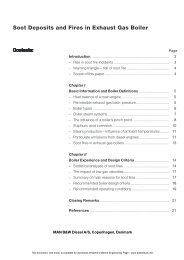Fire on Board the Liberian Passenger Ship Ecstasy, Miami, Florida ...
Fire on Board the Liberian Passenger Ship Ecstasy, Miami, Florida ...
Fire on Board the Liberian Passenger Ship Ecstasy, Miami, Florida ...
- No tags were found...
Create successful ePaper yourself
Turn your PDF publications into a flip-book with our unique Google optimized e-Paper software.
Analysis 74 Marine Accident ReportCarnival Cruise Lines owns seven o<strong>the</strong>r Fantasy Class ships that may have similarpropulsi<strong>on</strong> system arrangements as <strong>the</strong> <strong>Ecstasy</strong>. In corresp<strong>on</strong>dence to Safety <strong>Board</strong>investigators, <strong>the</strong> cruise ship company did not indicate whe<strong>the</strong>r it had examined orintended to examine its o<strong>the</strong>r vessels to identify design problems in <strong>the</strong>ir propulsi<strong>on</strong>systems. The Safety <strong>Board</strong>, <strong>the</strong>refore, believes that Carnival should examine <strong>the</strong>propulsi<strong>on</strong> systems <strong>on</strong> <strong>the</strong> ships in its fleet and, if necessary to provide redundancy,modify <strong>the</strong> arrangement of <strong>the</strong> auxiliary voltage circuitry to <strong>the</strong> high-speed breakers wherea single source supplies both port and starboard propulsi<strong>on</strong> systems.The company that designed <strong>the</strong> <strong>Ecstasy</strong>’s propulsi<strong>on</strong> system, ABB, is a majorsupplier of cycloc<strong>on</strong>verter propulsi<strong>on</strong> systems to marine customers. C<strong>on</strong>sequently, o<strong>the</strong>rvessels might be operating with an ABB propulsi<strong>on</strong> system similar in design to that <strong>on</strong> <strong>the</strong><strong>Ecstasy</strong>. The Safety <strong>Board</strong>, <strong>the</strong>refore, believes that ABB should advise its customers withships having <strong>the</strong> same propulsi<strong>on</strong> system design arrangements as <strong>the</strong> <strong>Ecstasy</strong> of <strong>the</strong>potential for system failure from <strong>the</strong> loss of auxiliary voltage to <strong>the</strong> high-speed breakersand recommend design changes to <strong>the</strong> propulsi<strong>on</strong> system that would minimize <strong>the</strong>seeffects.Even though <strong>the</strong> <strong>Ecstasy</strong>’s propulsi<strong>on</strong> system had a number of design features thatwere intended to reduce <strong>the</strong> likelihood that both port and starboard systems would fail as aresult of single fault, <strong>the</strong> importance of isolating <strong>the</strong> auxiliary voltage source to <strong>the</strong> highspeedbreakers was not identified before or during <strong>the</strong> vessel c<strong>on</strong>structi<strong>on</strong>. ABB officialsstated that <strong>the</strong>y did not do a formal failure analysis, such as an FMEA, of <strong>the</strong> propulsi<strong>on</strong>system design because SOLAS, LR, and Carnival did not require <strong>the</strong>m to perform <strong>on</strong>e.A qualitative failure analysis, such as <strong>the</strong> FMEA method, can identify potentialfailures and rank <strong>the</strong>m according to <strong>the</strong> probability of occurrence, <strong>the</strong> severity of effects,and <strong>the</strong> probability of detecti<strong>on</strong>. System failure analyses are widely used in many o<strong>the</strong>rindustries as part of <strong>the</strong> overall movement toward quality improvement in processes andproducts. In additi<strong>on</strong>, IMO now requires that a failure analysis be performed during <strong>the</strong>design of navigati<strong>on</strong> equipment and bridge systems. The Coast Guard has required <strong>the</strong> usequalitative failure analysis techniques in evaluating <strong>the</strong> reliability and safety of vitalsystem automati<strong>on</strong> <strong>on</strong> U.S. flag vessels since 1988. In proposing <strong>the</strong> regulatoryrequirement that designers, manufacturers, and/or shipyards perform and submit systemfailure analysis, <strong>the</strong> Coast Guard stated that <strong>the</strong> use of advanced automati<strong>on</strong> technologiessuch as electr<strong>on</strong>ics and microprocessors made it increasingly difficult, “at timesimpossible, for <strong>the</strong> Coast Guard, ship owners/operators, and classificati<strong>on</strong> societies toevaluate safety.”Classificati<strong>on</strong> societies, however, have not seen <strong>the</strong> need to require failure analyses<strong>on</strong> vital automati<strong>on</strong> systems in spite of <strong>the</strong> fact that <strong>the</strong>se systems are becoming even morecomplex and difficult to evaluate. The LR stated that during its plan approval and surveysof <strong>the</strong> <strong>Ecstasy</strong>’s c<strong>on</strong>structi<strong>on</strong>, it was not provided details of <strong>the</strong> propulsi<strong>on</strong> system’sinternal c<strong>on</strong>necti<strong>on</strong>s. Therefore, LR was not aware, prior to <strong>the</strong> casualty, that <strong>the</strong>propulsi<strong>on</strong> would be lost if <strong>the</strong> cables to <strong>the</strong> high-speed breakers were burned through.
















